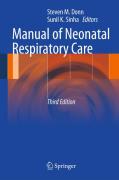
This popular book covers the 'how-to' of the respiratory care of newborns inoutline format. It includes case studies for self-review and is illustrated with high quality radiographic images, figures, tables, and algorithms. Written and edited by international experts, the Third Edition is a thorough updateand remains a convenient source of practical information on respiratory physiology, exam techniques, tips for performing procedures, radiography, ventilation, pain management, transport, and discharge planning.•Up-to-date clinical information from world experts.•Case studies.•Easy-to-consult outline format.•Condensed information about all of the major mechanical ventilators (e.g., modes, displays, and alarms).'The extent of coverage, easy readability, superb organization [and] 'apractical pearls make [this book] worthwhile'asimply a great bargain.' --Journal of Perinatology (review of a previous edition). INDICE: SECTION I. Lung Development and Maldevelopment.- Chapter 1. Development of the Respiratory System.- Chapter 2. Developmental Lung Anomalies.- SECTION II. Principles of Mechanical Ventilation.- Chapter 3. Spontaneous Breathing.- Chapter 4. Pulmonary Gas Exchange.- Chapter 5. Oxygen Therapy.- Chapter 6. Oxygen Toxicity.- Chapter 7. Pulmonary Mechanics.- Chapter 8. Basic Principles of Mechanical Ventilation.- Chapter 9. Classification of Mechanical Ventilation Devices.- Chapter 10. Ventilator Parameters.- Chapter 11. Respiratory Gas Conditioning and Humidification.- SECTION III. Procedures and Techniques.- Chapter 12. Clinical Examination.- Chapter 13. Neonatal Resuscitation.- Chapter14. Laryngoscopy and Endotracheal Intubation.- Chapter 15. Vascular Access.- Chapter 16. Tracheostomy.- SECTION IV. Monitoring the Ventilated Patient.- Chapter 17. Continuous Monitoring Techniques.- Chapter 18. Pulse Oximetry.- Chapter 19. Interpretation of Blood Gases.- Chapter 20. Neonatal Pulmonary Graphics.- Chapter 21. Radiography.- Chapter 22. Transillumination.- Chapter 23. Echocardiography.- Chapter 24. Bronchoscopy.- SECTION V. Non-Invasive Ventilatory Techniques.- Chapter 25. Nasal Cannula Therapy.- Chapter 26. Continuous Positive Airway Pressure.- Chapter 27. Non-invasive Ventilation.- SECTION VI. Ventilatory Modes and Modalities.- Chapter 28. Positive End Expiratory Pressure.- Chapter 29. Intermittent Mandatory Ventilation.- Chapter 30. Synchronized Intermittent Mandatory Ventilation.- Chapter 31. Assist/Control Ventilation.- Chapter 32. Volume-Targeted Ventilation.- Chapter 33. Pressure Control Ventilation.-Chapter 34. Pressure Support Ventilation.- Chapter 35. Proportional Assist Ventilation.- SECTION VII. High-Frequency Ventilation.- Chapter 36. High-Frequency Ventilation: General Concepts.- Chapter 37. High-Frequency Jet Ventilation.- Chapter 38. High-Frequency Oscillatory Ventilation.- SECTION VIII. Commonly Used Neonatal Ventilators.- Chapter 39. VIP BIRD Gold Ventilator.- Chapter 40.AVEA Ventilator.- Chapter 41. Bear Cub 750psv.- Chapter 42. Newport Wave.- Chapter 43. Newport e360T.- Chapter 44. Draeger Babylog VN500 Infant and Pediatric Ventilator.- Chapter 45. Servo-i Ventilator/NAVA.- Chapter 46. SLE 5000 andSLE 4000 Infant Ventilators.- Chapter 47. Bunnell Life-Pulse High-Frequency Jet Ventilator.- Chapter 48. SensorMedics 3100A High-Frequency Oscillatory Ventilator.- SECTION IX. Adjunctive Therapies.- Chapter 49. Hemodynamic Support.- Chapter 50. Nutritional Support of Ventilated Infants.- Chapter 51. SurfactantReplacement Therapy.- Chapter 52. Pharmacologic Agents.- Chapter 53. Automatic Control of Oxygen Delivery.- Chapter 54. Sedation and Analgesia.- Chapter 55. Inhaled Nitric Oxide Therapy.- Chapter 56. Extracorporeal Membrane Oxygenation.- Chapter 57. Liquid Ventilation for Neonatal Respiratory Failure.- SECTIONX. Management of Common Neonatal Respiratory Diseases.- Chapter 58.Mechanismsof Respiratory Failure.- Chapter 59. Tissue Hypoxia.- Chapter 60. Indicationsfor Mechanical Ventilation.- Chapter 61. Respiratory Distress Syndrome.- Chapter 62. Pneumonia.- Chapter 63. Meconium Aspiration Syndrome.- Chapter 64. Persistent Pulmonary Hypertension of the Newborn.- Chapter 65. Congenital Diaphragmatic Hernia.- Chapter 66. Pulmonary Hypoplasia/Agenesis.- Chapter 67. Apnea Syndromes.- Chapter 68. Weaning and Extubation.- SECTION XI. Bronchopulmonary Dysplasia.- Chapter 69. Etiology and Pathogenesis.- Chapter 70. Management.- Chapter 71. Long-Term Outcome of Newborns with Bronchopulmonary Dysplasia.- SECTION XII. Complications Associated With Mechanical Ventilation.- Chapter 72. Thoracic Air Leaks.- Chapter 73. Patent Ductus Arteriosus.- Chapter 74. Neonatal Pulmonary Hemorrhage.- Chapter 75. Retinopathy of Prematurity.- Chapter 76. Neurologic Complications of Mechanical Ventilation.- SECTION XIII. Other Considerations.- Chapter 77. Nursing Care of the Ventilated Infant.- Chapter 78. Transport of Ventilated Babies.- Chapter 79. Home Ventilation.- Chapter 80. Discharge Planning and Follow-Up of the NICU Graduate.- SECTION XIV. Ethical and Legal Considerations.- Chapter 81. Initiation of Life Support at the Border ofViability.- Chapter 82. Withdrawal of Ventilatory Support.- Chapter 83. Medical Liability, Documentation, and Risk Management.- SECTION XV. Research and the Literature.- Chapter 84. Interpreting Medical Literature.- Chapter 85. Contemporary Classics in Neonatal Respiratory Care.
- ISBN: 978-1-4614-2154-2
- Editorial: Springer
- Encuadernacion: Rústica
- Fecha Publicación: 14/02/2012
- Nº Volúmenes: 1
- Idioma: Inglés
